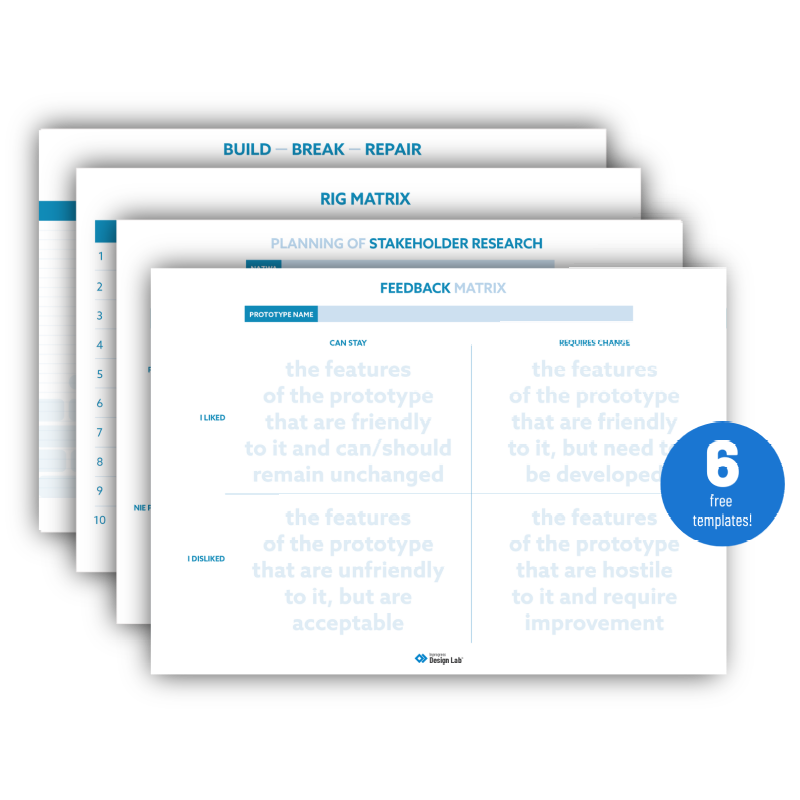DTTools
Challenge Tree
Allows the DTTeam to collect in one place all information about the Challenge, understand the status quo, reasons and consequences relating to the Challenge. Thanks to this tool, you will accomplish the first analysis of the Challenge.
Questionnaires
The list of questions used to interview the stakeholders. You can select traditional or online surveys. Surveys allow to get to know opinions of various stakeholders and organise the collected data.
Observation
The DTDesigners assess the authentic situation and register all observed actions. For example, they can observe an office area, how the employees are moving around it and see their mutual interactions. Based on that the DTTeam will draw conclusions which will help designing a better room arrangement or communication methods.
Interviews
Interviews with the stakeholders will help to collect necessary data and understand their perspective. Combining interviews with observation is another technique, called contextual interviews.
Desk Research
Gathering as much as possible of the detailed data and information about the Challenge. During Desk Research the DTDesigner can, for example, analyse documents of the organisation or other resources relating to the Challenge. If possible, they should also familiarise themselves with the scientific literature, in order to better understand fields relating to the subject.
User Stories
A User Story is an expression which will highlight the needs of stakeholders. Each of the Stories carries knowledge gathered by the DTDesigners during their research. This tool will allow you to visually present the needs in a short and accessible way.
Matrix of Needs
This tool will allow you to structure the User Stories. The Matrix of Needs consists of two axises, where the DTDesigners place stakeholders’ needs, depending on their importance and representativeness. This tool will very well organises the collected data after having studied the stakeholders.
6-3-5 Method
Allows to generate ideas individually. Six participants have five minutes to write down three ideas (each on their own piece of paper). Then they pass the piece of paper with the ideas to the person on their left. Within the next five minutes, they read the received ideas and add three new ones. Then they pass the piece of paper to the person on their left. The cycle is repeated until the DTDesigners receive their original piece of paper.
Clustering
Generated ideas are divided into sets (clusters) containing common functions and features of the Solution. Each set is given a name. The best name for a cluster is the common denominator for the ideas it contains.
The Now-How-Wow Matrix
In this tool, ideas are assessed based on their feasibility and originality, reflected in the coordinate system. This approach, in an easy way, helps to decide which ideas to reject, which are easy to implement but are not very original (Now), difficult to implement but original (How), and which are simple to implement and original (Wow).
Dot Voting
This is another tool for selecting ideas to develop. Dots are a visualization of the voice of every DTDesigner. Thanks to them, it is easy to identify the most popular ideas. Each of the DTDesigners receives 3 dots which they can vote with, dividing them between different ideas or giving all votes to one chosen one.
RIG Matrix
It is used for detailed analysis and final prioritization of the best ideas. This matrix will help to accurately compare individual elements - i.e., ideas. Everyone completes the task individually, but the results are presented collectively.
Build-Break-Repair
Build-Break-Repair is a tool that allows you to create a detailed description of your best ideas. One DTDesigner describes the idea (builds it); the second points for weaknesses in this description (breaks it); and the third one solves the identified problems (fixes it). All participants work parallelly, similar to the 6-3-5 method.
Creating a prototype
The task of the DTTeam is to create a tangible prototype of the idea. It can be presented in the form of a drawn screen, a comic book, a cardboard structure, or a role-play that shows the interaction of the stakeholder with a potential solution.
Testing
The purpose of the tests is to check whether the Solution meets the real needs of the Stakeholders. The tests are conducted by showing prototypes to testers and collecting feedback from them. Other tools, such as, surveys, or observation, can also be used for testing.
Feedback
These are the opinions of people who tested the prototypes. It is used to obtain constructive and critical information, thanks to which the prototype can be adapted to the real needs of Stakeholders.
Description of the solution
It is a detailed description of the Solution – created action plan and carefully considered hierarchy of functionalities. The functions will be divided into must-have, should-have and could-have categories.


Do you want to try the proven Design Thinking tools?
- tools that are used in the DTMethod process
- 6 templates, thanks to which you will start working on your own Solution
DTTools - download free templates
See the remaining components of the DTMethod
The methodology of Design Thinking
process management stands on three pillars:
- DTModel,consisting of 3 phases,
- DTTools,around 20 tools adjusted to DTModel
- DTRules&Roles, i.e., the rules (and roles) that must be followed when using DTMethod.


Want to know more?
Contact us. We would be happy to discuss the details.